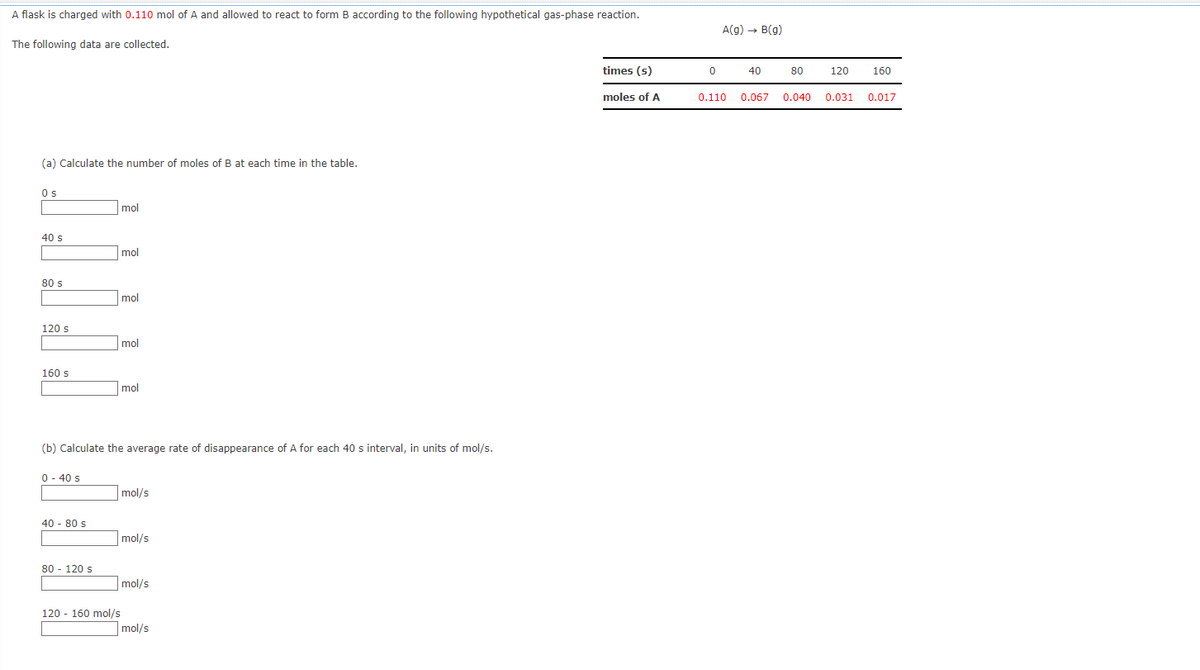A flask is charged with 0.110 mol of A and allowed to react to form B according to the following hypothetical gas-phase reaction. The following data are collected. (a) Calculate the number of moles of B at each time in the table. Os 40 s 80 s 120 s 160 s 0-40 s 40 - 80 s mol 80 - 120 s mol mol (b) Calculate the average rate of disappearance of A for each 40 s interval, in units of mol/s. mol mol mol/s mol/s mol/s 120 - 160 mol/s mol/s times (s) moles of A 0 A(g) → B(g) 40 0.110 0.067 80 0.040 120 160 0.031 0.017
A flask is charged with 0.110 mol of A and allowed to react to form B according to the following hypothetical gas-phase reaction. The following data are collected. (a) Calculate the number of moles of B at each time in the table. Os 40 s 80 s 120 s 160 s 0-40 s 40 - 80 s mol 80 - 120 s mol mol (b) Calculate the average rate of disappearance of A for each 40 s interval, in units of mol/s. mol mol mol/s mol/s mol/s 120 - 160 mol/s mol/s times (s) moles of A 0 A(g) → B(g) 40 0.110 0.067 80 0.040 120 160 0.031 0.017
Chemistry for Engineering Students
4th Edition
ISBN:9781337398909
Author:Lawrence S. Brown, Tom Holme
Publisher:Lawrence S. Brown, Tom Holme
Chapter11: Chemical Kinetics
Section: Chapter Questions
Problem 11.50PAE
Related questions
Question

Transcribed Image Text:A flask is charged with 0.110 mol of A and allowed to react to form B according to the following hypothetical gas-phase reaction.
The following data are collected.
(a) Calculate the number of moles of B at each time in the table.
Os
40 s
80 s
120 s
160 s
0 - 40 s
40 - 80 s
80 120 s
mol
120 160 mol/s
mol
(b) Calculate the average rate of disappearance of A for each 40 s interval, in units of mol/s.
mol
mol
mol
mol/s
mol/s
mol/s
mol/s
times (s)
moles of A
0
A(g) → B(g)
40
0.110 0.067
80
120
160
0.040 0.031 0.017
Expert Solution
This question has been solved!
Explore an expertly crafted, step-by-step solution for a thorough understanding of key concepts.
This is a popular solution!
Trending now
This is a popular solution!
Step by step
Solved in 3 steps with 3 images

Knowledge Booster
Learn more about
Need a deep-dive on the concept behind this application? Look no further. Learn more about this topic, chemistry and related others by exploring similar questions and additional content below.Recommended textbooks for you

Chemistry for Engineering Students
Chemistry
ISBN:
9781337398909
Author:
Lawrence S. Brown, Tom Holme
Publisher:
Cengage Learning

General Chemistry - Standalone book (MindTap Cour…
Chemistry
ISBN:
9781305580343
Author:
Steven D. Gammon, Ebbing, Darrell Ebbing, Steven D., Darrell; Gammon, Darrell Ebbing; Steven D. Gammon, Darrell D.; Gammon, Ebbing; Steven D. Gammon; Darrell
Publisher:
Cengage Learning

Chemistry: Principles and Reactions
Chemistry
ISBN:
9781305079373
Author:
William L. Masterton, Cecile N. Hurley
Publisher:
Cengage Learning

Chemistry for Engineering Students
Chemistry
ISBN:
9781337398909
Author:
Lawrence S. Brown, Tom Holme
Publisher:
Cengage Learning

General Chemistry - Standalone book (MindTap Cour…
Chemistry
ISBN:
9781305580343
Author:
Steven D. Gammon, Ebbing, Darrell Ebbing, Steven D., Darrell; Gammon, Darrell Ebbing; Steven D. Gammon, Darrell D.; Gammon, Ebbing; Steven D. Gammon; Darrell
Publisher:
Cengage Learning

Chemistry: Principles and Reactions
Chemistry
ISBN:
9781305079373
Author:
William L. Masterton, Cecile N. Hurley
Publisher:
Cengage Learning

Chemistry: The Molecular Science
Chemistry
ISBN:
9781285199047
Author:
John W. Moore, Conrad L. Stanitski
Publisher:
Cengage Learning

Chemistry: Principles and Practice
Chemistry
ISBN:
9780534420123
Author:
Daniel L. Reger, Scott R. Goode, David W. Ball, Edward Mercer
Publisher:
Cengage Learning

Chemistry: An Atoms First Approach
Chemistry
ISBN:
9781305079243
Author:
Steven S. Zumdahl, Susan A. Zumdahl
Publisher:
Cengage Learning